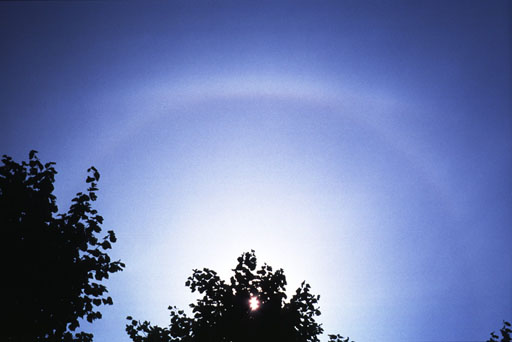

Upper Tangential Arc of a Sun Halo


| Date: | 16.8.1998
| Instrument: | f=35mm
|
| Place: | Bonn
| Observer: | T. Credner, S. Kohle
|
© Copyright by the observers
Halos result from sunlight (or moonlight) being bent by randomly distributed
hexagonal ice crystals in the atmosphere. These crystals deviate the light
more or equal 22 degrees, depending on the crystals orientation. But never
less than 22 degrees! This minimum deviation leads to the circular 22 degree
halo with its sharp inner edge and fuzzy outer edge.
But if the crystals show a preferred orientation, some details in the outer
halo are more pronounced. In the upper image we can see a brightening
on top of the 22 degree halo and next to it arcs that deviate from
the main halo. In all this is called the "upper tangent arc".
It is the result of a preferred horizontal orientation of the crystal's axis
of symmetry. Especially falling hexagonal needles favor this "lying" orientation.
Above the sun, the minimum deviation of the horizontal needles
remains 22 degrees, but it increases beside and thus leading
to these extra arcs.
Is the sun higher than 40 degrees above the horizon, a complete circumscribed
halo appears. It touches the 22 degree halo at the upper and lower border,
but is more extended at the sides.

